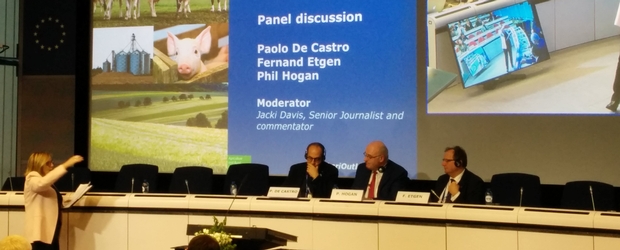ICOS participate in Agriculture Outlook Conference – Dairy to look to World Markets

Both ICOS President, Martin Keane and CEO, Seamus O’Donohoe participated in the commodity sessions of this high level conference in Brussels.
From a dairy perspective, the main presentation was led by Sophie Helaine from the Agricultural modelling and outlook unit of DG Agri in the Commission.
This article will just cover some of the headline observations of the report from a dairy focused point of view.
Notwithstanding current difficulties in the market the underlying trend for dairy continues to be positive with global demand continuing at a 2% a year growth rate which has been long projected.
This growth remains concentrated in developing 3rd country markets and much of it will be satisfied by their own internal domestic supply.
While China remains important to dairy trade demand, hovering 25% of global dairy trade, Africa in particular was cited for its growing importance, which makes our industry’s recent visits and investments in the region look increasingly shrewd.
The Russian Ban still continues to weigh on the market in terms of global dairy demand, but the Commission projections are hoping for an ending of the ban by the end of 2016. ICOS is heavily lobbying on this highly political piece.
The report notes in the growth of New Zealand due to environmental and natural resource constraints and states that this will give EU exporting dairy economies, such as Ireland, an opportunity to contribute more.
From an internal EU market point of view, the commission underlined that 90% of milk produced is still consumed internally, but that there was developments in how that dairy was consumed with long term consumption declines in liquid milk and yogurt offset by growth in cream, butter and cheese.
The commission noted that the 6.5 billion litre increase in supply in 2014 (bigger than total Irish production) was exceptional.
In terms of farm gate milk price, the commission sees an average milk price of between 32 to 34c a litre for the next 5 years and then milk price will climb as demand outstrips supply.
They see an concentration of production with the likes of Ireland, Poland, Denmark and some of the Baltic region countries leading the line, with Germany, France & and UK big countries that will also see growth.
In terms of limitations on EU dairy growth, Environmental issues such as Nitrates & Phosphates as well as the Green House Gas emissions being the key obstacles that the industry has to address and surmount.
Finally, from a trade flow point of view, there was good news for dairy trade reliant countries like us in Ireland, with the EU projected to have significant growth in market shares of key sectors such as whey, cheese, SMP and Butter. The Kiwis are slated to continue to dominate WMP sector.
By Conor Mulvihill
European Affairs Executive